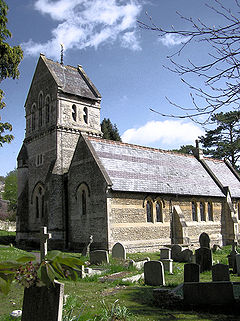Monkton Combe
| Monkton Combe | |
|---|---|
 St Michael's Church |
|
| Monkton Combe shown within Somerset | |
| Population | 554 |
| OS grid reference | ST771620 |
| Unitary authority | |
| Ceremonial county | |
| Region | |
| Country | England |
| Sovereign state | United Kingdom |
| Post town | BATH |
| Postcode district | BA2 |
| Dialling code | 01225 |
| Police | Avon and Somerset |
| Fire | Avon |
| Ambulance | South Western |
| EU Parliament | South West England |
| UK Parliament | |
Monkton Combe is a village and civil parish in north Somerset, England, 3 miles (4.8 km) south of Bath. The parish, which includes the hamlet of Tucking Mill, has a population of 554.
Monkton Combe was part of the hundred of Bath Forum.
According to Rev. John Collinson in his History of Somerset (1791), the town's proper name is Combe Monkton, or really just Combe with the Monkton being attached as an adjective to differentiate it from neighbouring Combe Down and Combe Grove. The village was originally owned by the monks of Bath Abbey, hence Monkton Combe.
It was on the route of the (now disused) Somerset Coal Canal, which ran parallel to Midford Brook.
Monkton Combe railway station featured in the 1953 film The Titfield Thunderbolt, one of the Ealing comedies. The film's plot centred on efforts by villagers to preserve their local railway line. It was on the short-lived branch line of the Bristol and North Somerset Railway which went from Limpley Stoke to Camerton and had closed to passenger traffic in 1925, though the line was used for freight traffic from the Somerset coalfield until 1952.
The parish council has responsibility for local issues, including setting an annual precept (local rate) to cover the council’s operating costs and producing annual accounts for public scrutiny. The parish council evaluates local planning applications and works with the local police, district council officers, and neighbourhood watch groups on matters of crime, security, and traffic. The parish council's role also includes initiating projects for the maintenance and repair of parish facilities, such as the village car park and playgrounds, as well as consulting with the district council on the maintenance, repair, and improvement of highways, drainage, footpaths, public transport, and street cleaning. Conservation matters (including trees and listed buildings) and environmental issues are also of interest to the council. The Village Hall and Village Green are the responsibility of the Village Hall Committee and not of the Parish Council.
...
Wikipedia

